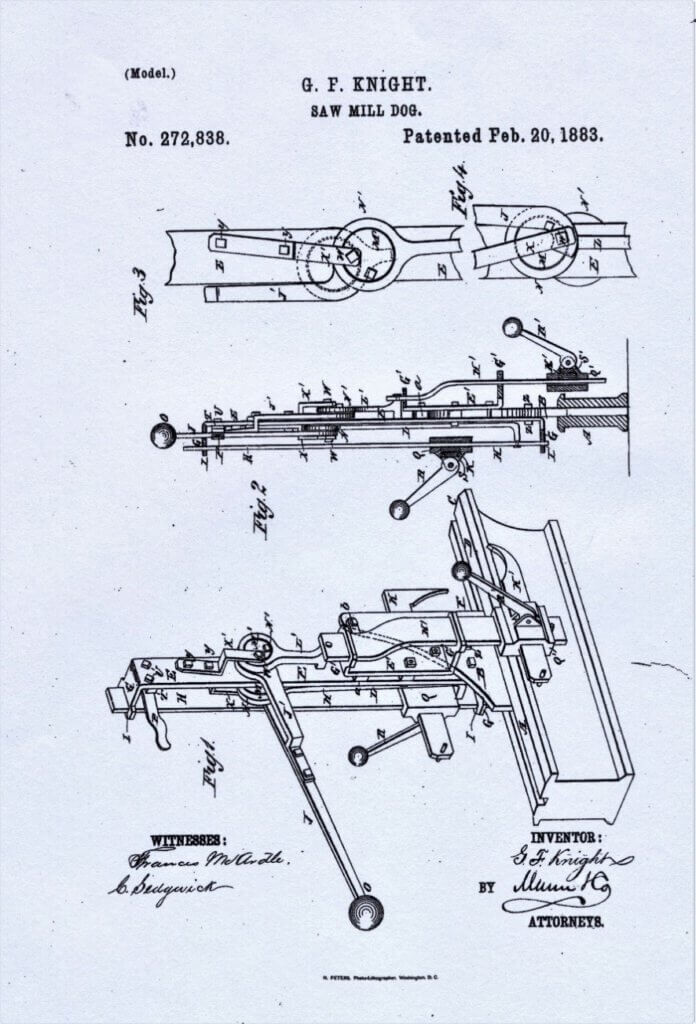Cant Hooks and Mill Dogs
Welcome to this week’s Bill’s History Corner. I’m going to be talking about dogs and hooks. It’s not at all what jumped into your mind; we are not going to be hooking dogs. I like dogs, but I like cats better.
We are still finding paper business receipts from the early days of the company, and in this History Corner, I really mean early; 1882 & 1883 are the years for these two receipts. In 1882, the business was named “J. C. Mellinger & Co.,” with John and Frank Coppes being the “& Co.” part of the name. John Mellinger was John & Frank’s older Brother-in-law who was operating the sawmill when the Coppes Brothers joined the business in 1876. By 1880, an older brother ,Samuel, also joined the business, and in 1883 the three Coppes Brothers purchased the business portion of the company owned by J. C. Mellinger. The company name then became “Coppes Bros. Co.” During this time, the (1880-1883) company operated the sawmill, selling retail and wholesale lumber. They purchased the box factory, owned by Mr. Strom, eventually moving it to the market Street site in 1884 and building a wheat elevator on the old box factory site at the railroad tracks in 1887. It was a busy time for them.
The first receipt I want to show is from REEVES & CO., Columbus, Ind., manufactures of the HOOSIER BOY CORN PLOW, REEVES’ STALK CUTTER, REEVES’ AUTOMATIC GATE, and a general line of farm machinery.

The writing on this receipt appears to be very sloppy, but really that was caused by folding the paper before the ink was dry. This receipt is dated Feb. 20, 1882. The J. C. Mellinger & Co. ordered five (A. B. Reeves Pat.) “Cant Hooks” for a price of $10.00. I’ve hunted the Patent Office web site for the A. B. Reeves Pat. cant hooks but have not found it. I’m also sure that everyone knows what a CANT HOOK is, but just in case you may have forgotten, here is a drawing from an Eric Sloane book.

The Coppes sawmill workers moved 1000s of logs each year, the CANT HOOK gave the workers more leverage when attempting to move or roll heavy logs. Likely there were dozens of these tools at the sawmill and on the log wagons. I still don’t know how they loaded the huge logs onto wagons in the woods. Any thoughts about that?
As I was hunting for the cant hook patent, I did find several interesting things about the Reeves Co. In 1882, the time of this receipt, there were three members of the company management: Albert B. Reeves (remember the Patent) and his two nephews, Marshall T. Reeves and Milton M. Reeves. Among the three of them, they had more than 150 U.S. Patents, mostly for farm-related machinery. The Reeves Company grew into a huge company, producing a line of large steam engines, hit & miss engines, automobiles, and farm machinery. The Reeves Co. is also famous for producing the 8-wheel car pictured here. Wish I had one of them. Remember, these cars were made in Columbus, Ind. Makes me proud.

A second receipt I want to show is from May 11th, 1882. J. C. Mellinger & Co. purchased 2 pair (does 2 pair mean 4? ) of Excelsior Mill Dogs at a price of $100.00. There was a 50% discount, so the total cost to Mellinger was $50.00.
Mill Dogs are the clamping part of the Saw-Mill carriage that the log rides on as it rolls past the saw blade. With each pass, a cut is made, and a board is cut off the log. The number of passes and the times the log was turned (rolled using cant hooks) on the carriage is determined by the size of lumber (boards) the sawyer wants to cut from each log. Each time the log is turned it is then refastened with the mill dogs.
I found the patent drawing for a Knight Mill Dog, but notice the date on the patent drawing is eight months after the date on the receipt selling a patented mill dog. The Knight’s patent mill dog apparently worked very good for the Coppes Bros. as they were promoting themselves as being agents (dealers?) for the Knight’s Patent Mill Dog in the local newspaper in 1881.

These receipts are a type of spotlight on the business practices of the early years of the business. So far, these receipts (a box full) from 1879-1883 and some early pictures and ledgers are the only way we have of understanding the business. Other than these factual documents, there is little other information telling the day to day operation of the company. The Coppes Bros. were too busy with the day to day operations to think about their legacies. As far as I know, there are no diaries from any of the Coppes family.
I think it is safe to say, the three Coppes Bros. and their extended families greatly influenced the growth and very survival of our town. The kitchen cabinet industry has put Nappanee “on the map”.

